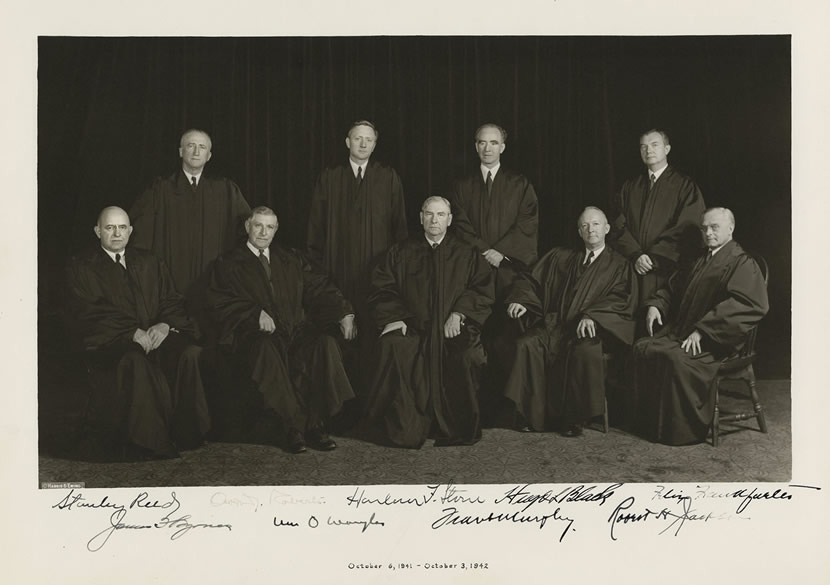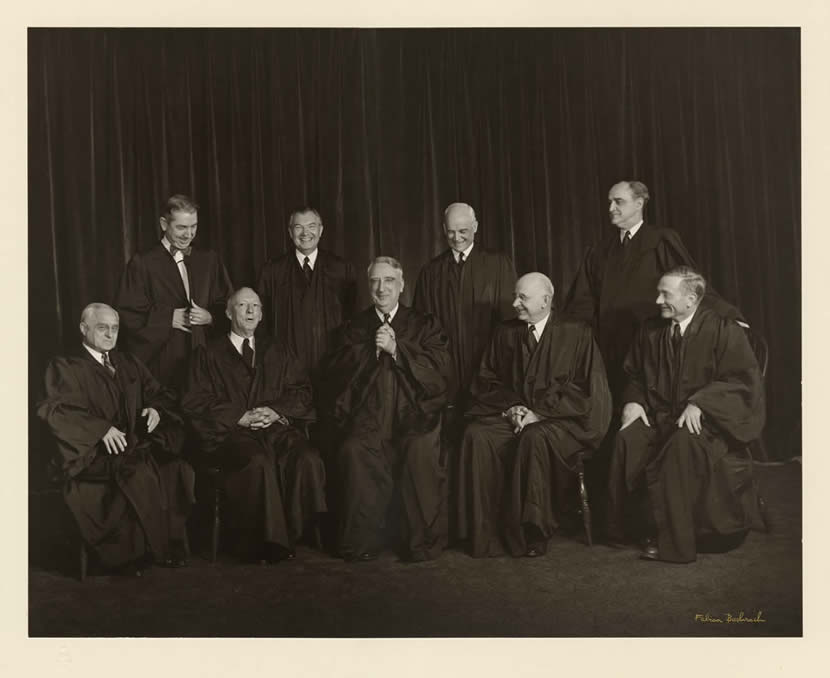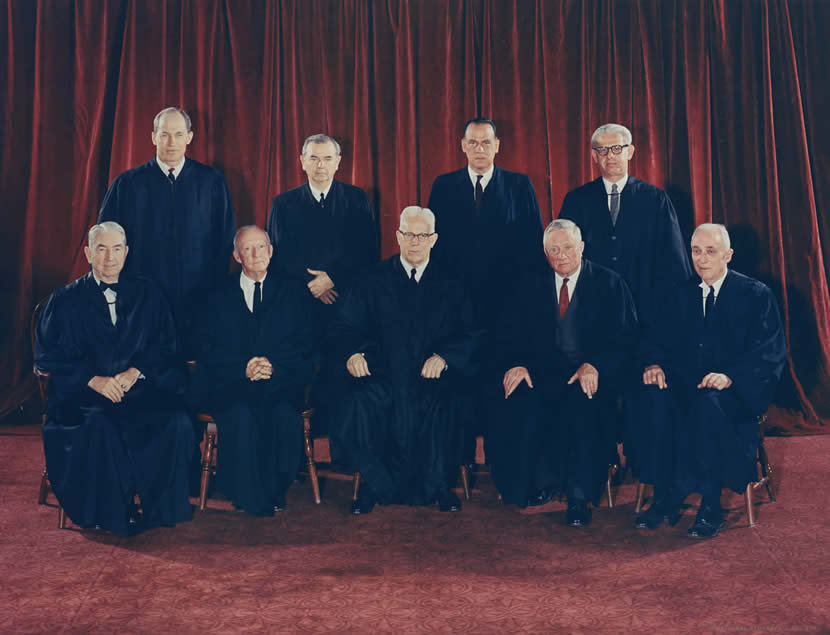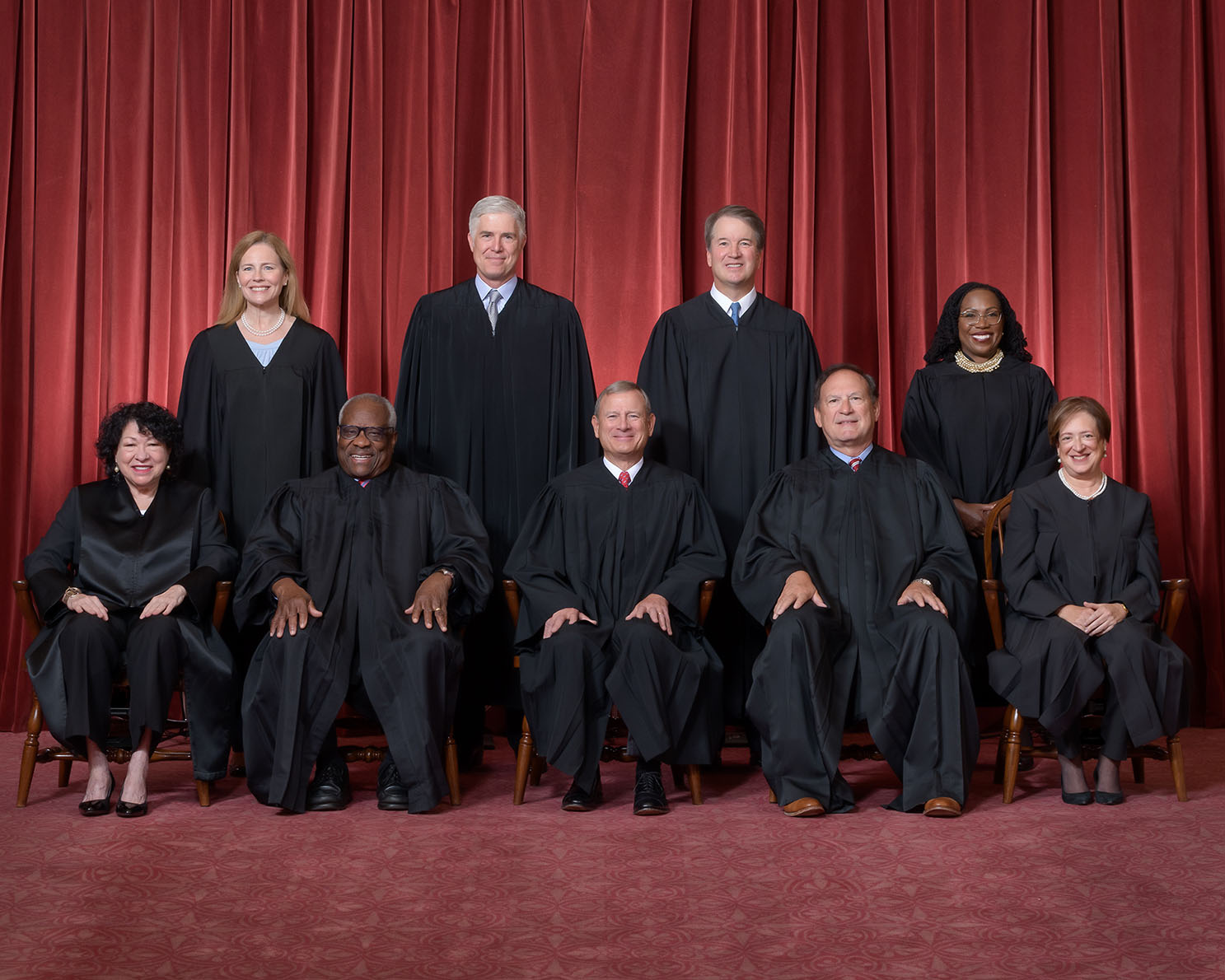1940s-Present: At Home and In Color
Since 1941, every group photograph has been taken in the Supreme Court Building, and since 1965 they have been taken in color.
The Stone Court, October 1941 [signed]
Harris & Ewing Studio (active 1905-1977)
 Seated, from left: Justices Stanley F. Reed and Owen J. Roberts, Chief Justice Harlan Fiske Stone, and Justices Hugo L. Black and Felix Frankfurter; standing, from left: Justices James F. Byrnes, William O. Douglas, Frank Murphy, and Robert H. Jackson
Seated, from left: Justices Stanley F. Reed and Owen J. Roberts, Chief Justice Harlan Fiske Stone, and Justices Hugo L. Black and Felix Frankfurter; standing, from left: Justices James F. Byrnes, William O. Douglas, Frank Murphy, and Robert H. Jackson
Harris & Ewing’s 10-year monopoly on the group photograph particularly annoyed the other members of the White House News Photographers Association. When Harlan Fiske Stone became Chief Justice in 1941, the Association’s president promptly wrote him and proposed that all eleven members be allowed to take the group photograph, and also suggested the portrait session take place in the new Supreme Court Building. The plea worked, and that year a humbled Harris & Ewing was one of three studios to take official photographs of the Court, one after the other. Official photographs have been taken in the Supreme Court Building ever since.
The Vinson Court, May 1950
Fabian Bachrach, Jr. (1917-2010)
 Seated, left: Justices Felix Frankfurter and Hugo L. Black, Chief Justice Fred M. Vinson, and Justices Stanley F. Reed and William O. Douglas; standing, from left: Justices Tom C. Clark, Robert H. Jackson, Harold H. Burton, and Sherman Minton
Seated, left: Justices Felix Frankfurter and Hugo L. Black, Chief Justice Fred M. Vinson, and Justices Stanley F. Reed and William O. Douglas; standing, from left: Justices Tom C. Clark, Robert H. Jackson, Harold H. Burton, and Sherman Minton
One of the new photographers in the 1940s was Fabian Bachrach, Jr., who ran a distinguished national chain of portrait studios. In 1950, his quick thinking—aided by new high-speed lighting equipment—led to this spontaneous and humorous moment in the Court’s family album of group photographs. An article later published by The Saturday Evening Post explained:
Wanting the subjects more tightly grouped, [Bachrach’s assistant William] Pennington said, “Justice Clark, will you move to the left?” At this request Chief Justice Frederick M. Vinson threw up his hands in mock horror, rolled his eyes and intoned “Oh, God forbid!” The court burst into laughter, and Fabian caught their gleeful moment with high-speed flash.
Perhaps because it was so clearly out of character with the typical solemnity for such photographs, just 10 final prints from this negative were made—one for each Justice, and one for Pennington’s private office. The photograph enjoyed a quiet fame within the Supreme Court Building until it was finally published for the first time, with the Court’s permission, in The Saturday Evening Post 11 years later, in 1961.
The Warren Court, June 1965
Joseph Scherschel (1920-2004), for the National Geographic Society
 Seated, from left: Justices Tom C. Clark and Hugo L. Black, Chief Justice Earl Warren, and Justices William O. Douglas and John M. Harlan; standing, from left: Justices Byron R. White, William J. Brennan, Jr., Potter Stewart, and Arthur J. Goldberg
Seated, from left: Justices Tom C. Clark and Hugo L. Black, Chief Justice Earl Warren, and Justices William O. Douglas and John M. Harlan; standing, from left: Justices Byron R. White, William J. Brennan, Jr., Potter Stewart, and Arthur J. Goldberg
While the press had been taking group photographs of the Justices in color since the 1940s, this is the first official group photograph to be taken in color. It was taken for a book on the Supreme Court titled Equal Justice Under Law, which was co-published by the National Geographic Society and the Federal Bar Association. Because this same group of Justices sat together for an official photograph in 1962, it is also a rare exception to the rule that the Court sits for a group photograph only after a change in membership.
With this first color official group photograph, all of the primary visual elements of this tradition fell into place. The seating arrangement was established at Bell’s studio in 1894; the velvet drapery was first used by Clinedinst’s studio in 1916, and made permanent by Harris & Ewing in 1930; and the carpeting of the Court’s large, ceremonial conference rooms can be seen in every photograph taken since 1941.
The Roberts Court, October 2022
Fred Schilling (1970- ) for the Supreme Court
 Seated, from left: Justices Sonia Sotomayor and Clarence Thomas, Chief Justice John G. Roberts, Jr., and Justices Samuel A. Alito,
Jr. and Elena Kagan; standing, from left: Justices Amy Coney Barrett, Neil M. Gorsuch, Brett M. Kavanaugh, and Ketanji Brown Jackson
Seated, from left: Justices Sonia Sotomayor and Clarence Thomas, Chief Justice John G. Roberts, Jr., and Justices Samuel A. Alito,
Jr. and Elena Kagan; standing, from left: Justices Amy Coney Barrett, Neil M. Gorsuch, Brett M. Kavanaugh, and Ketanji Brown Jackson
For over five decades, the official group photograph has invariably been taken in color, in the Supreme Court’s red-carpeted East Conference Room. The Justices have posed in the same seating arrangement and in front of red velvet drapery. The only major variables are the arrival, departure, and placement of the individual Justices (and the photographer). The price of this iconic appearance is that the only elements available for photographers to tweak are minor variations in lighting, spacing, and choice of lens, which can make the Justices feel closer to or farther away from the viewer.
Since 2005, the official group photographs have been taken by the Supreme Court’s photographer.
The current Court, formed with the arrival of Justice Ketanji Brown Jackson in June 2022, is the 55th group of Justices to gather together for this purpose. This sitting was the third all-digital official photograph session, at which no film was used.